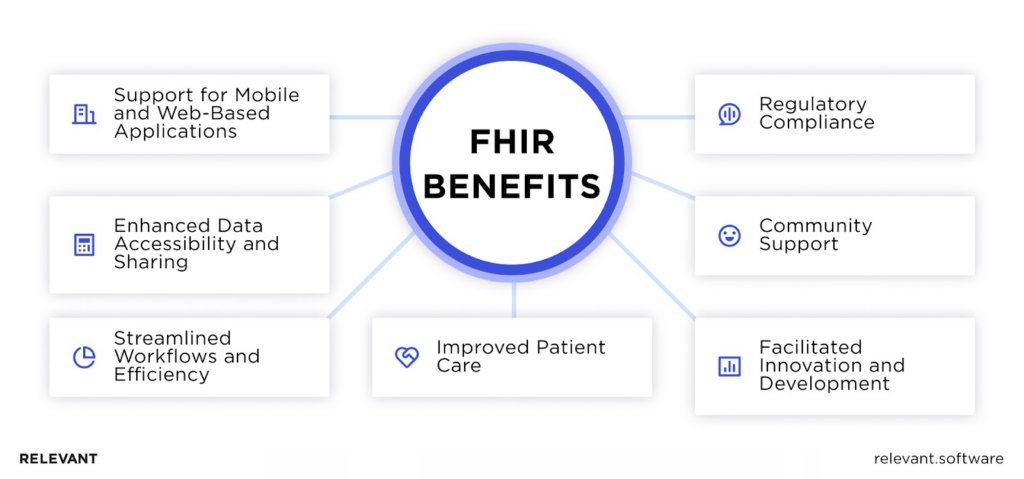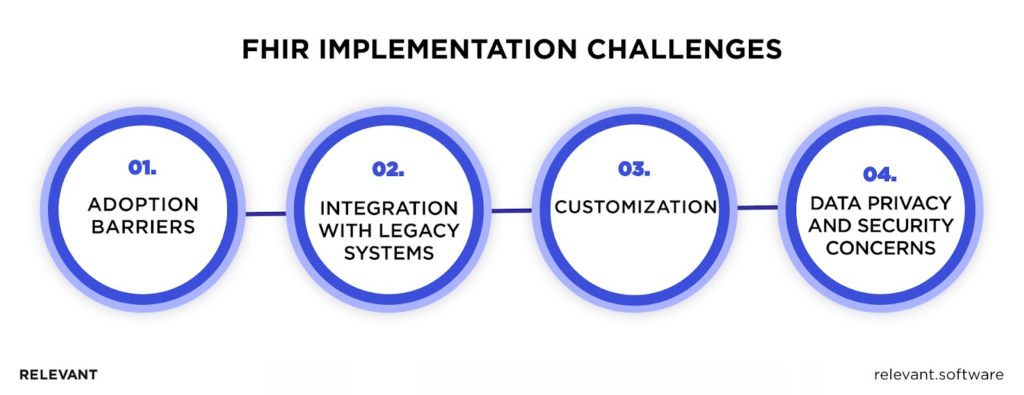FHIR Healthcare: Empowering Interoperability in the Digital Age
Digital technology such as artificial intelligence (AI) and large-scale “big data” analytics has had a significant impact on various sectors, including healthcare. The shift from paper-based systems to electronic health records (EHRs) is now commonplace, improving the quality of patient care.
However, a key hurdle in this digital transformation is interoperability – the ability for systems to interact and share data effortlessly. To address this, the healthcare industry was turning to a powerful tool: FHIR (Fast Healthcare Interoperability Resources), a breakthrough in healthcare data exchange.

We provide companies with senior tech talent and product development expertise to build world-class software. Let's talk about how we can help you.
Contact usIn this article, we will explore how the FHIR standard is changing the rules of the game, enabling efficient data exchange and paving the way for a new era of interoperability in healthcare. Whether you’re a healthcare professional, IT specialist, or simply someone interested in the future of healthcare, this exploration of FHIR healthcare will enlighten and inspire you.
Table of Contents
What Makes Interoperability So Crucial?
The global healthcare interoperability market has witnessed significant growth, projected to reach $8 billion by 2024, driven by the exponential expansion of clinical data. However, data inaccuracy poses a major challenge, exemplified by the fragmented Electronic Health Records (EHR) systems used across US health systems.
Vital patient data remains trapped in “data silos,” with outdated systems perpetuating the use of emails and faxes for record transmission. That hinders effective communication and causes clinicians to lack comprehensive patient history while researchers struggle to access anonymized data required for their studies.
To tackle this issue, the Centers for Medicare & Medicaid Services (CMS) has implemented the Interoperability and Patient Access rule, promoting data-sharing efficiency through standards like FHIR (Fast Healthcare Interoperability Resources).

What are FHIR and Its “Resources”?
Fast Healthcare Interoperability Resources (FHIR) represents a worldwide acclaimed standard for the digital exchange of health-focused information. Developed and refined by HL7 International, this standard addresses healthcare data complexity and standardizes data sharing interfaces across the entire ecosystem via individual APIs.
At the core of FHIR is a comprehensive framework of “resources” that outline precise clinical concepts, empowering the management of these resources independently or their seamless aggregation into sophisticated documents. This modular approach allows systems to work with only the types of data they are interested in rather than needing to handle entire documents or messages.
While FHIR integration necessitates considerable investment, its many improvements to healthcare processes justify this outlay.
- For patients, the FHIR healthcare standard promotes more informed, high-quality care. Interoperability facilitates swift data transmission when selecting an insurance plan and affords patients increased control over their Personal Health Information (PHI).
- For healthcare teams, FHIR provides easy access to understandable health records, a crucial aspect of the healthcare industry. As patients navigate the healthcare ecosystem, these records allow teams to maintain a comprehensive patient profile and consolidate all healthcare app data, optimizing workflow and eliminating the need for multiple devices.
- For healthcare providers, the FHIR standard ensures compliance with industry norms, optimizes operations, and aids the shift toward value-based care. Interoperability boosts productivity, safeguards patient data, and enhances the return on investment for EHR systems.
- For developers, the FHIR standard clarifies the rules for ensuring interoperability. This clarity allows them to build compliant healthcare systems capable of processing data from Medicare and Medicaid-eligible individuals. Consequently, these systems meet the needs of a larger pool of healthcare organizations, including those required to adhere to the Patient Access Final Rule.
How is FHIR different from HL7?
While both FHIR and HL7 v2/v3 are standards developed by Health Level Seven International, they are significantly different in their design, technology, and use cases.
HL7 v2 and v3 are earlier standards that use a message-based approach to exchange healthcare data. However, they have been critiqued for their complexity and lack of compatibility. HL7 v2 messages are often customized for each implementation, leading to interoperability challenges. On the other hand, HL7 v3 attempted to resolve this with a highly prescriptive approach but resulted in a steep learning curve and implementation challenges.
FHIR, as the newest standard, aims to address these issues. Its resource-based approach is more flexible and intuitive, allowing for easier implementation. FHIR is designed for the web; it supports RESTful architectures, and data can be exchanged in XML or JSON format. This makes it more compatible with modern software development practices and technologies.

Furthermore, FHIR supports standardized terminologies, such as LOINC for lab tests and SNOMED CT for clinical terms. This standardization enables more precise and dependable information transfer across diverse systems.
In summary, while HL7 v2 and v3 have played crucial roles in healthcare data exchange, FHIR represents a significant evolution in overall coordination, focusing on ease of implementation, web compatibility, and semantic interoperability. Thus, FHIR strikes the right balance, improving upon its predecessors.
Key Features of FHIR Healthcare Standard
The FHIR standard significantly transforms healthcare by boosting innovation and enhancing efficiency and patient focus. We will explore its functionalities and subsequent effects on healthcare operations to grasp its influence on information exchange.
Resource-based approach
In FHIR, data elements are grouped into standardized “resources,” individual units representing various clinical concepts. Almost 150 resources in the FHIR specification encompass essential aspects like patients, providers, organizations, devices, medications, diagnostics, care plans, and finance. This resource-based organization offers granular access to data, enabling systems to interact with the required data elements rather than dealing with entire documents or messages.
RESTful API
FHIR leverages RESTful (Representational State Transfer) APIs, which align with the architecture of the modern web, facilitating seamless integration with current technologies. These APIs allow for simple and standard data transmission methods, including create, read, update, and delete (CRUD) operations, making FHIR an intuitive and efficient standard for healthcare data exchange.
Modular components
The modularity of FHIR resources is another key feature of this standard. Resources within FHIR can be utilized individually or combined to create intricate documents or workflows. This modular approach offers remarkable flexibility, streamlining the implementation of FHIR. Systems are free to adopt and utilize only the resources that align with their specific requirements.
Extensibility and scalability
FHIR offers a robust mechanism that allows resources to be extended to cater to specific use cases, all while maintaining seamless interoperability. This means that FHIR can adapt and accommodate unique requirements without sacrificing its ability to integrate and exchange information effectively. Moreover, FHIR can scale to handle large volumes of data and a wide range of healthcare scenarios, from simple data exchange to complex clinical workflows.
JSON and XML support
FHIR supports JSON (JavaScript Object Notation) and XML (eXtensible Markup Language) formats for data exchange, ensuring compatibility with various technologies and software environments. That allows developers to choose the format that best fits their needs and preferences, further facilitating the implementation and use of FHIR in diverse healthcare information systems.
Benefits of FHIR for Healthcare Organizations
Indeed, the advantages that FHIR brings to the table are multifaceted and substantial. The standard serves as a catalyst for innovation and streamlining healthcare processes. Its adoption promotes:

Improved Patient Care
FHIR contributes to superior patient care by facilitating real-time, seamless access to health data. This comprehensive, current view of patient health data enables healthcare providers to make informed and timely decisions, leading to improved patient outcomes.
Enhanced Data Accessibility and Sharing
The resource-based approach of FHIR, coupled with its utilization of RESTful APIs, makes healthcare data more accessible and easier to share among different systems. This enhanced data accessibility and interoperability can lead to improved coordination of care and a reduction in duplicate tests and treatments.
Streamlined Workflows and Efficiency
Simplifying healthcare data exchange, FHIR offers significant benefits in streamlining workflows and improving efficiency within healthcare organizations. Reducing administrative burdens allows healthcare professionals to allocate more attention to patient care.
Support for Mobile and Web-Based Applications
FHIR’s compatibility with modern web technologies makes it an optimal choice for developing mobile and web-based applications. This compatibility enhances patient engagement by granting individuals access to their health data and facilitating seamless interaction with healthcare providers.
Facilitated Innovation and Development
FHIR’s flexible and intuitive framework for healthcare data exchange paves the way for innovation and development within the healthcare sector. This framework empowers the creation of novel tools and services that aim to enhance patient care and optimize healthcare operations, fostering continuous advancement and improvement in the industry.
Regulatory Compliance
With the increasing regulatory focus on data interoperability, adopting FHIR can help healthcare organizations comply with such regulations as the CMS Interoperability and Patient Access rule. This can assist organizations in avoiding penalties and maintaining their reputation in the healthcare industry.
Community Support
As an open standard developed by HL7, FHIR is supported by a global community of healthcare and IT professionals. This community offers valuable resources, guidance, and support for implementing and using FHIR, making it a reliable and sustainable choice for healthcare data exchange.
FHIR Implementation Challenges
Implementing FHIR, like any significant technological shift, is not without its hurdles. While the standard offers a promising path toward seamless data interoperability, healthcare organizations embarking on this journey must be prepared to navigate a landscape marked by complexities and challenges. Specifically, these encompass:

Adoption Barriers
These include a lack of awareness or understanding of the standard, resistance to change, and the perceived complexity of implementation. Also, the need for a significant initial investment in terms of time, resources, and training can deter healthcare organizations from fully embracing FHIR.
Integration with Legacy Systems
Integrating these older systems with FHIR can be a complex task that requires careful planning and execution. It’s crucial to ensure data compatibility and maintain system performance during and after integration.
Need for Customization and Additional Development
Customization and additional development may be necessary to tailor the FHIR standard to an organization’s unique needs. But this customization can add to the complexity and cost of FHIR implementation.
Data Privacy and Security Concerns
The healthcare sector remains a prominent target for cybercriminal activities, underscoring the critical need to safeguard patient health information’s confidentiality and integrity. Paramount among these protective strategies is the securing of APIs.
Real-World Examples of FHIR Implementation
FHIR garners support from industry giants like Google and Microsoft, alongside prominent EHR vendors like Epic and Cerner. Furthermore, the FHIR ecosystem already boasts an impressive count of approximately two million FHIR apps.
Consequently, many organizations have shown interest in embracing the FHIR standard. Some have already made the strategic move to incorporate FHIR into their operations. Let’s examine five innovative applications that demonstrate the capabilities and promise of FHIR:
Apple Health Records
Apple Health Records utilizes FHIR standards to allow iPhone users to access their electronic health records (EHRs) directly on their devices. It consolidates data from multiple healthcare providers, creating a comprehensive and real-time patient health information overview. That includes crucial details like allergies, conditions, immunizations, lab results, medications, and vitals.
SMART on FHIR
Substitutable Medical Apps, Reusable Technologies (SMART) on FHIR is an innovative platform that empowers the creation of healthcare applications capable of functioning seamlessly across diverse healthcare systems. By leveraging the FHIR standards, SMART on FHIR enables these applications to securely access and utilize a wide range of health data, fostering a climate of innovation in healthcare technology.
Sync for Science (S4S)
Sync for Science (S4S) is an initiative launched by the National Institutes of Health (NIH) to facilitate data synchronization for scientific research purposes. The project aims to advance precision medicine research by enabling easy and secure data sharing between individuals and researchers.
Argonaut Project
The Argonaut Project represents a private sector endeavor that employs FHIR to engineer a pioneering API and Core Data Services specification, aiming to bolster health information’s interoperability. It brings together health IT vendors and provider organizations to accelerate the adoption of FHIR in healthcare systems.
The United Kingdom’s National Health Service (NHS)
The NHS in the UK has adopted FHIR as a key standard for its digital services. It uses FHIR to enable interoperability between different healthcare systems and to facilitate the development of new services and applications, enhancing patient care and healthcare operations nationwide.
Hence, why not take a cue from these successful implementations and join the ranks of those reaping the benefits of FHIR? Our expert team is fully prepared to steer you through this transformative process. But first, find out on 👇
How Relevant Software Contributes to the Implementation of FHIR
At Relevant Software, we offer an all-encompassing spectrum of FHIR healthcare software development services related to product engineering, rooted in our deep understanding of the healthcare domain.
Whether comprehending the operation of FHIR APIs in your specific context or maneuvering through third-party apps and APIs aligned with FHIR Release 4, our consultants stand prepared to provide the necessary guidance and support.
We enable smooth communication, customer-focused solutions, clinical and financial integrations, and advanced activation procedures tailored to individual and collective requirements. Regardless of your position in your FHIR journey, whether you require your IT team augmentation or not, we are here to help.
Bottom Line
The question of whether we can support FHIR is one we frequently encounter, and our response is an emphatic yes. However, it is essential to recognize that while FHIR is a significant enabler, it is not a universal solution for all interoperability challenges.
With this understanding, we assist healthcare organizations in navigating the ever-evolving landscape of trends and regulatory requirements that shape their patient-centric initiatives. Discover more about our integration and interoperability capabilities, and contact us for HL7 FHIR Service.
FAQ
Our core services:
Do you want a price estimate for your project?
Do you know that we helped 200+ companies build web/mobile apps and scale dev teams?
Let's talk about your engineering needs.
Write to us











